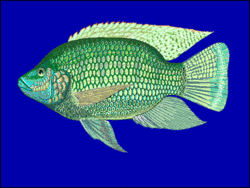Biology:Oreochromis placidus
| Oreochromis placidus | |
|---|---|

| |
| Scientific classification | |
| Domain: | Eukaryota |
| Kingdom: | Animalia |
| Phylum: | Chordata |
| Class: | Actinopterygii |
| Order: | Cichliformes |
| Family: | Cichlidae |
| Genus: | Oreochromis |
| Species: | O. placidus
|
| Binomial name | |
| Oreochromis placidus Trewavas, 1941
| |
The black tilapia (Oreochromis placidus) is a freshwater species of fish of the genus Oreochromis, found in the wide region of Southern Africa. It is a edible tropical fish.[2]
Description
The black tilapia can grow to the recorded maximum length of 35.5 cm (14 inches).[3] The fish is silvery to steel-grey, with white abdomen. There is a red or orange margin on the dorsal and grey or black marblings on the gill-cover.[4] The species are only reported to be found in fresh water at low altitudes and latitudes which suggests its relatively low salinity and temperature tolerances.[5]
Distribution
The species are mainly found in the lower Zambezi river and other rivers southwards such as Runde, Pungwe, Rovuma and Buzi river.[6] It is also found in the lakes nearby.[7]
References
- ↑ "Reference Summary - IUCN, 2022". https://fishbase.mnhn.fr/references/FBRefSummary.php?ID=126983.
- ↑ Eissa, Alaa Eldin; Attia, Marwa M.; El Zlitne, Rabia A.; Magdy, Ayad A.; Edrees, Asmaa; Sharaf, Mahmoud S.; Mahmoud, Abeer E.; Abdelbaky, Awad A. et al. (22 November 2023). "The puzzling etiologies of transient black discoloration in Nile Tilapia (Oreochromis niloticus) intensively cultured under RAS system" (in en). Aquaculture International. doi:10.1007/s10499-023-01328-9. ISSN 1573-143X. https://link.springer.com/article/10.1007/s10499-023-01328-9. Retrieved 3 December 2023.
- ↑ El-Sayed, Abdel-Fattah M (1 September 1999). "Alternative dietary protein sources for farmed tilapia, Oreochromis spp.". Aquaculture 179 (1): 149–168. doi:10.1016/S0044-8486(99)00159-3. ISSN 0044-8486. https://www.sciencedirect.com/science/article/abs/pii/S0044848699001593. Retrieved 3 December 2023.
- ↑ Nascimento, Beatriz Miguez; de Paula, Thiago Silva; Brito, Paulo Marques Machado (1 December 2023). "DNA barcode of tilapia fish fillet from the Brazilian market and a standardized COI haplotyping for molecular identification of Oreochromis spp. (Actinopterygii, Cichlidae)". Forensic Science International: Animals and Environments 3: 100059. doi:10.1016/j.fsiae.2022.100059. ISSN 2666-9374. https://www.sciencedirect.com/science/article/pii/S2666937422000191. Retrieved 3 December 2023.
- ↑ Dalu, T; Clegg, Bw; Nhiwatiwa, T (29 November 2013). "A study of the ichthyofauna of a small tropical reservoir, south-eastern lowveld, Zimbabwe" (in en). African Journal of Aquatic Science 38 (sup1): 105–113. doi:10.2989/16085914.2013.768953. ISSN 1608-5914. https://www.tandfonline.com/doi/abs/10.2989/16085914.2013.768953. Retrieved 3 December 2023.
- ↑ Shechonge, Asilatu; Ngatunga, Benjamin P.; Bradbeer, Stephanie J.; Day, Julia J.; Freer, Jennifer J.; Ford, Antonia G. P.; Kihedu, Jonathan; Richmond, Tabitha et al. (2019). "Widespread colonisation of Tanzanian catchments by introduced Oreochromis tilapia fishes: the legacy from decades of deliberate introduction". Hydrobiologia 832 (1): 235–253. doi:10.1007/s10750-018-3597-9. ISSN 0018-8158. PMC 6394791. https://www.ncbi.nlm.nih.gov/pmc/articles/PMC6394791/. Retrieved 3 December 2023.
- ↑ Bradbeer, Stephanie J.; Harrington, Jack; Watson, Henry; Warraich, Abrahim; Shechonge, Asilatu; Smith, Alan; Tamatamah, Rashid; Ngatunga, Benjamin P. et al. (1 April 2019). "Limited hybridization between introduced and Critically Endangered indigenous tilapia fishes in northern Tanzania" (in en). Hydrobiologia 832 (1): 257–268. doi:10.1007/s10750-018-3572-5. ISSN 1573-5117. https://link.springer.com/article/10.1007/s10750-018-3572-5. Retrieved 3 December 2023.
Wikidata ☰ {{{from}}} entry
 |


